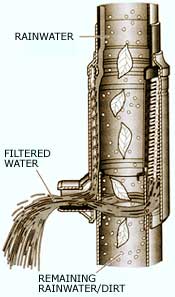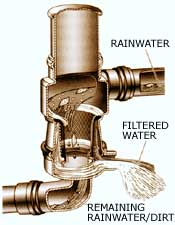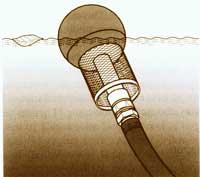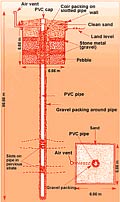COMPONENTS OF A RAINWATER HARVESTING SYSTEM
A rainwater harvesting system comprises components of various
stages - transporting rainwater through pipes or drains, filtration,
and storage in tanks for reuse or recharge. The common components
of a rainwater harvesting system involved in these stages are
illustrated here.
1.
Catchments: The catchment of a water harvesting
system is the surface which directly receives the rainfall and
provides water to the system. It can be a paved area like a
terrace or courtyard of a building, or an unpaved area like
a lawn or open ground. A roof made of reinforced cement concrete
(RCC), galvanised iron or corrugated sheets can also be used
for water harvesting.
2.
Coarse mesh at the roof to prevent the passage
of debris
3. Gutters:
Channels all around the edge of a sloping roof to collect and
transport rainwater to the storage tank. Gutters can be semi-circular
or rectangular and could be made using:
- Locally available material such as plain galvanised iron
sheet (20 to 22 gauge), folded to required shapes.
- Semi-circular gutters of PVC material can be readily prepared
by cutting those pipes into two equal semi-circular channels.
- Bamboo or betel trunks cut vertically in half.
The size of the gutter should be according to the flow during
the highest intensity rain. It is advisable to make them 10
to 15 per cent oversize.
Gutters need to be supported so they do not sag or fall
off when loaded with water. The way in which gutters are fixed
depends on the construction of the house; it is possible to
fix iron or timber brackets into the walls, but for houses
having wider eaves, some method of attachment to the rafters
is necessary.
4. Conduits
Conduits are pipelines or drains that carry rainwater from the
catchment or rooftop area to the harvesting system. Conduits
can be of any material like polyvinyl chloride (PVC) or galvanized
iron (GI), materials that are commonly available.
The following table gives an idea about the diameter of pipe
required for draining out rainwater based on rainfall intensity
and roof area:
Sizing
of rainwater pipe for roof drainage
|
Diameter Of pipe (mm)
|
Average rate of rainfall
in mm/h
|
| |
50 |
75 |
100 |
125 |
150 |
200 |
| 50 |
13.4 |
8.9 |
6.6 |
5.3 |
4.4 |
3.3 |
| 65 |
24.1 |
16.0 |
12.0 |
9.6 |
8.0 |
6.0 |
| 75 |
40.8 |
27.0 |
20.4 |
16.3 |
13.6 |
10.2 |
| 100 |
85.4 |
57.0 |
42.7 |
34.2 |
28.5 |
21.3 |
| 125 |
- |
- |
80.5 |
64.3 |
53.5 |
40.0 |
| 150 |
- |
- |
- |
- |
83.6 |
62.7 |
5. First-flushing
A first flush device is a valve that ensures that runoff from
the first spell of rain is flushed out and does not enter the
system. This needs to be done since the first spell of rain
carries a relatively larger amount of pollutants from the air
and catchment surface.
6.
Filter
The filter is used to remove suspended pollutants from rainwater
collected over roof. A filter unit is a chamber filled with
filtering media such as fibre, coarse sand and gravel layers
to remove debris and dirt from water before it enters the storage
tank or recharge structure. Charcoal can be added for additional
filtration.
(i) Charcoal water filter
A simple charcoal filter can be made in a drum or an earthen
pot. The filter is made of gravel, sand and charcoal, all of
which are easily available.
(ii) Sand filters
Sand filters have commonly available sand as filter media.
Sand filters are easy and inexpensive to construct. These
filters can be employed for treatment of water to effectively
remove turbidity (suspended particles like silt and clay),
colour and microorganisms.
In a simple sand filter that can be constructed domestically,
the top layer comprises coarse sand followed by a 5-10 mm
layer of gravel followed by another 5-25 cm layer of gravel
and boulders.
(ii. a) Dewas filters
Most residents in Dewas, Madhya Pradesh, have wells in their
houses. Formerly, all that those wells would do was extract
groundwater. But then, the district administration of Dewas
initiated a groundwater recharge scheme. The rooftop water was
collected and allowed to pass through a filter system called
the Dewas fillter, designed by Mohan
Rao , district collecter of Dewas, and engineers of the
rural engineering services. The water thus filtered is put into
the service tubewell.
The filter consists of a polyvinyl chloride (PVC) pipe 140
mm in diameter and 1.2m long. There are three chambers. The
first purification chamber has pebbles varying between 2-6
mm, the second chamber has slightly larger pebbles, between
6 and 12 mm and the third chamber has the largest - 12-20
mm pebbles. There is a mesh at the outflow side through which
clean water flows out after passing through the three chambers.
The cost of this filter unit is Rs 600.
Filter for large rooftops
When rainwater is harvested in a large rooftop area, the
filtering system should accommodate the excess flow. A system
is designed with three concentric circular chambers in which
the outer chamber is filled with sand, the middle one with
coarse aggregate and the inner-most layer with pebbles.
This way the area of filtration is increased for sand, in relation
to coarse aggregate and pebbles. Rainwater reaches the centre
core and is collected in the sump where it is treated with few
tablets of chlorine and is made ready for consumption. This
system was designed by
R Jeyakumar
Varun:S
Vishwanath, a Bangalore water harvesting expert, has developed
a rainwater filter "VARUN". According to him, from
a decently clean roof 'VARUN' can handle a 50 mm per hour intensity
rainfall from a 50 square metre roof area. This means the product
is relatively standardised. For new house builders we therefore
can recommend the number of downpipes they have to optimise
on and the number of filters they will need.
'VARUN' is made from a 90 litre
High Density Poly Ethylene (HDPE) drum. The lid is turned
over and holes are puched in it. This is the first sieve which
keeps out large leaves, twigs etc. Rainwater coming out of
the lid sieve then passes through three layers of sponge and
a 150 mm thick layer of coarse sand. Presence of sponge makes
the cleaning process very easy. Remove the first layer of
sponge and soak /clean it in a bucket of water (which you
then don't waste but use it for plants). The sand needs no
cleaning at all. The basic cost of the filter is about Rs
2250/-
ii. b. Horizontal roughing filter and
slow sand filter
The introducton of horizontal roughing filter and slow sand
filter (HRF/SSF) to treat surface water has made safe drinking
water available in coastal pockets of Orissa. The major components
of this filter are described below.
1) Filter channel : One
square metre in cross-section and eight m in length, laid across
the tank embankment, the filter channel consists of three uniform
compartments, the first packed with broken bricks, the second
with coarse sand, followed by fine sand in the third compartment.
The HRF usually consists of filter material like gravel and
coarse sand that successively decreases in size from 25 mm to
4 mm. The bulk of solids in the incoming water is separated
by this coarse filter media or HRF. At every outlet and inlet
point of the channel, fine graded mesh is implanted to prevent
entry of finer materials into the sump. The length of a channel
varies according to the nature of the site selected for the
sump.
2) Sump: A storage provision
to collect filtered water from the tank through the filter channel
for storage and collection.
While HRF acts as a physical filter and is applied to retain
solid matter, SSF is primarily a biological filter, used to
kill microbes in the water. Both filter types are generally
stable, making full use of the natural purification process
of harvested surface water and do not require any chemicals.
For more details:
Making Water Everybody's Business
iii. Rain PC
AcquaSure, a consortium of three specialist Netherlands-based
companies, has developed a system for the conversion of rainwater
to drinking water in the form of a Rainwater Purification Centre
(RainPC).
RainPC is developed by scaling down the multi-staged water
treatment method (MST), which involves screening, flocculation
sedimentation and filtration and incorporating existing technologies
like upward flow fine filtration, absorption and ion exchange.
Coming in a small compact 26 kg unit, the RainPC offers an
affordable solution by converting rainwater into drinking
water.
RainPC is made of ultra violet resistant poly-ethylene housing
and cover, stainless steel rods and bolts, a nickel-brass
valve and an adapter for maintaining constant volume. Xenotex-A
and activated carbon catridges along with ultra membrane filtration
or micro-membrane filtration modules incorporated in the RainPC
has the capacity to deal with E-coli and the potential of
meeting the Dutch as well as World Health Organisations (WHO)
water regulation standards. The components can also be transported
individually to be assembled at the site. Three product types
are available based on their microbial contaminant removal
capacity. This technology is ideally suited for virtually
any situation and is a blessing particularly for those who
have little or no access to regular safe drinking water.
|
The salient features of Rain
PC are:
- Simple straight-forward installation
- Easy to operate and maintain
- Needs no power and operates at low gravity pressure
(0.1 bar upward).
- The system is capable of providing a constant flow
of about 40 liters of rainwater per hour, enough for
a family of five for drinking, cooking and bathing
purposes.
- Maintains nearly constant volume irrespective of
water pressure.
- The Xenotex-A and activated carbon cartridge processes
up to 20,000 liters and can be regenerated up to 10
times.
- Cost per 1000 litres is as low as US$ 2 to 3.
|
(The above information is as per the manufacturers' claims
and not based on any study by CSE.)
For further information Email: cleanwater@aquasure.nl
iv. Rainwater harvester
EA Water Pvt Ltd has launched a unique Rainwater Harvester,
which filters runoff water from roads, which generally contains
oil and grease. This system has been installed in the Gymkhana
club, Sector-15, Faridabad, Haryana. Rajit Malohtra, project
in charge, of this company explained that the water harvesting
system installed at the club has a sand filter, which filters
silt from runoff harvested from roof, lawns and parking area.
The cost of the filter is around Rs 60,000.
For more details, contact
EA Water PVT Limited,
504 empire apartments,
Mehrauli-Gurgaon Road,
Sultanpur
New Delhi-110 030
Phone: 011-2680062
Website: www.eawater.com
Filters available in the German
Market
According to Wessels (1994), concerns over the possible negative
health effects of rainwater utilisation led to some opposition.
The Federal Office of Health, for example, intially objected
to its use for washing clothes, personal hygiene and even
for toilet flushing, due to possible risks of infection and
allergic reactions. Long-term investigations by the health
offices in Hamburg and Bremen, however, have yielded positive
results with respect to the use of water for washing purposes
and have confirmed that rainwater sources do not present a
health risk.
(i) Filters developed by WISY
Private companies such as WISY, based in Kefenrod in Germany,
are playing an important role in promoting rainwater use by
developing pumps and filter devices to improve water quality.
WISY has developed a simple filter system, which can be attached
to a standard household downpipe. Under conditions in Germany
(assuming a mean annual rainfall of 650mm/year), this can
divert and filter 90 per cent of the runoff from a roof area
of up to 200 square metre.

(a) |
(fig a). A filter collector diverts 90 per cent of rainwater
to a storage tank through a 0.17 mm stainless steel mesh filter.

(b) |
(fig b). A larger vortex fine filter can cope with run-off
from roof areas of up to 500 square metre.

(c) |
(fig c). A floating fine suction filter for ensuring
that the water pumped from the tank is extracted from the cleanest
part of the tank and is free of particulates has also been developed.
For details contact:
WISY (Winkler system)
OT Hitzkirchen, Oberdorfstrasse 26,
D-63699, Kefendrod-Hitzkirchen
Germany; fax:+60-54-912129
Wisyag@t-online.de
(ii) Filters developed by MALLBETON
Another company, MALLBETON, a manufacturer of concrete tanks
and filters, based in Germany, is marketing a tank design
which manages any overflows (Konig, 1998). This is done by
constructing the top half of a sub-surface tank from a porous
concrete ring, which allows water to gradually seep into the
ground. While this reduces the volume of water available,
it does make householders eligible for waivers on their rainwater
drainage fees. These fees are already applied to householders
and businesses in about 25 per cent of Germany. The charges
that are levied on each square metre of roof area and sealed
surroundings can be substantial, such as in Bonn, so waivers
often provide significant savings.
7. Storage facility
There are various options available for the construction of
these tanks with respect to the shape, size and the material
of construction.
Shape: Cylindrical, rectangular
and square.
Material of construction:
Reinforced cement concrete, (RCC), ferrocement, masonry, plastic
(polyethylene) or metal (galvanised iron) sheets are commonly
used.
Position of tank: Depending
on space availability these tanks could be constructed above
ground, partly underground or fully underground. Some maintenance
measures like cleaning and disinfection are required to ensure
the quality of water stored in the container.
8. Recharge structures
Rainwater may be charged into the groundwater aquifers through
any suitable structures like dugwells, borewells, recharge
trenches and recharge pits.
Various recharge structures are possible - some which promote
the percolation of water through soil strata at shallower
depth (e.g., recharge trenches, permeable pavements) whereas
others conduct water to greater depths from where it joins
the groundwater (e.g. recharge wells). At many locations,
existing structures like wells, pits and tanks can be modified
as recharge structures, eliminating the need to construct
any structures afresh. Here are a few commonly used recharging
methods:
1. Recharging of dugwells and abandoned
tubewells.
In alluvial and hard rock areas, there are thousands of wells
which have either gone dry or whose water levels have declined
considerably. These can be recharged directly with rooftop
run-off. Rainwater that is collected on the rooftop of the
building is diverted by drainpipes to a settlement or filtration
tank, from which it flows into the recharge well (borewell
or dugwell).
If a tubewell is used for recharging, then the casing (outer
pipe) should preferably be a slotted or perforated pipe so
that more surface area is available for the water to percolate.
Developing a borewell would increase its recharging capacity
(developing is the process where water or air is forced into
the well under pressure to loosen the soil strata surrounding
the bore to make it more permeable).
If a dugwell is used for recharge, the well lining should
have openings (weep-holes) at regular intervals to allow seepage
of water through the sides. Dugwells should be covered to
prevent mosquito breeding and entry of leaves and debris.
The bottom of recharge wells should be desilted annually to
maintain the intake capacity.
Providing the following elements in the system can ensure
the quality of water entering the recharge wells:
1. Filter mesh at entrance point of rooftop drains
2. Settlement chamber
3. Filter bed
2. Settlement tank
Settlement tanks are used to remove silt and other floating
impurities from rainwater. A settlement tank is like an ordinary
storage container having provisions for inflow (bringing water
from the catchment), outflow (carrying water to the recharge
well) and overflow. A settlement tank can have an unpaved
bottom surface to allow standing water to percolate into the
soil.
In case of excess rainfall, the rate of recharge, especially
of borewells, may not match the rate of rainfall. In such
situations, the desilting chamber holds the excess amount
of water till it is soaked up by the recharge structure. Thus,
the settlement chamber acts like a buffer in the system.
Any container, (masonry or concrete underground tanks, old
unused tanks, pre-fabricated PVC or ferrocement tanks) with
adequate capacity of storage can be used as a settlement tank.
3. Recharging of service tubewells.
In this case the rooftop runoff is not directly led into the
service tubewells, to avoid chances of contamination of groundwater.
Instead rainwater is collected in a recharge well, which is
a temporary storage tank (located near the service tubewell),
with a borehole, which is shallower than the water table.
This borehole has to be provided with a casing pipe to prevent
the caving in of soil, if the strata is loose. A filter chamber
comprising of sand, gravel and boulders is provided to arrest
the impurities.
4. Recharge pits
A recharge pit is 1.5m to 3m wide and 2m to 3m deep. The excavated
pit is lined with a brick/stone wall with openings (weep-holes)
at regular intervals. The top area of the pit can be covered
with a perforated cover. Design procedure is the same as that
of a settlement tank.
5. Soakaways / Percolation
pit
Percolation pits, one of the easiest and most effective
means of harvesting rainwater, are generally not more than
60 x 60 x 60 cm pits, (designed on the basis of expected runoff
as described for settlement tanks), filled with pebbles or
brick jelly and river sand, covered with perforated concrete
slabs wherever necessary.
6.Recharge trenches
A recharge trench is a continuous trench excavated in the
ground and refilled with porous media like pebbles, boulders
or broken bricks. A recharge trench can be 0.5 m to 1 m wide
and 1 m to 1.5 m deep. The length of the recharge trench is
decided as per the amount of runoff expected. The recharge
trench should be periodically cleaned of accumulated debris
to maintain the intake capacity. In terms of recharge rates,
recharge trenches are relatively less effective since the
soil strata at depth of about 1.5 metres is generally less
permeable. For recharging through recharge trenches, fewer
precautions have to be taken to maintain the quality of the
rainfall runoff. Runoff from both paved and unpaved catchments
can be tapped.
7.Recharge troughs
To collect the runoff from paved or unpaved areas draining
out of a compound, recharge troughs are commonly placed at
the entrance of a residential/institutional complex.These
structures are similar to recharge trenches except for the
fact that the excavated portion is not filled with filter
materials. In order to facilitate speedy recharge, boreholes
are drilled at regular intervals in this trench. In design
part, there is no need of incorporating the influence of filter
materials.
This structure is capable of harvesting only a limited amount
of runoff because of the limitation with regard to size.
 |
8. Modified injection well
In this method water is not pumped into the aquifer but allowed
to percolate through a filter bed, which comprises sand and
gravel. A modified injection well is generally a borehole,
500 mm diameter, which is drilled to the desired depth depending
upon the geological conditions, preferably 2 to 3 m below
the water table in the area. Inside this hole a slotted casing
pipe of 200 mm diameter is inserted. The annular space between
the borehole and the pipe is filled with gravel and developed
with a compressor till it gives clear water. To stop the suspended
solids from entering the recharge tubewell, a filter mechanism
is provided at the top.
|







for urban areas